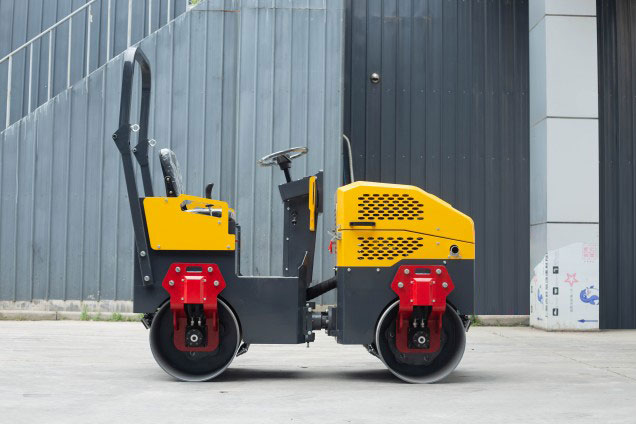Tandem Roller Mastery: 15 Key Benefits for Construction Success
Home » Tandem Roller Mastery: 15 Key Benefits for Construction Success

Table of Contents
What Is a Tandem Roller?
A tandem roller, often referred to as a double-drum road roller, is a type of compaction equipment used widely in the construction industry. It features two large steel drums — one at the front and one at the rear — that apply pressure and vibration to compact materials like asphalt, gravel, and soil.
These machines are especially effective in road construction, parking lot paving, and foundation compaction. Thanks to their dual-drum system, tandem rollers can compact both forward and backward, increasing coverage and efficiency.
How Does a Tandem Roller Work?
Tandem rollers work on two primary principles: static pressure and vibratory force. As the heavy drums roll over the surface, they apply pressure that pushes particles closer together. When vibration is engaged, it agitates particles beneath the surface, allowing for deeper and more thorough compaction.
Modern tandem rollers come equipped with hydraulic systems to control drum vibration, steering, and braking — making them more user-friendly and effective for both small and large-scale construction tasks.
Key Components of a Tandem Roller
Front and Rear Steel Drums
These are the heart of the machine. Made from thick, solid steel, these drums apply the necessary force to flatten and compact the surface.
Vibratory Mechanism
A vibration motor inside the drum creates rapid oscillations, helping materials settle more tightly and eliminating voids below the surface.
Hydraulic Steering and Braking System
This ensures smooth operation, improved safety, and precise control—especially when navigating tight spaces or curves.
15 Major Benefits of Using a Tandem Roller
1. Enhanced Compaction Efficiency
With two working drums, tandem rollers compress materials faster and more thoroughly than single-drum models.
2. Uniform Pressure Distribution
Both drums apply equal weight, ensuring a flat, even surface across the width of the machine.
3. Greater Coverage Area
The large drum width allows for fewer passes over the same area, improving productivity and reducing fuel usage.
4. Reduced Labor Costs
Because of their efficiency and larger coverage, fewer operators and machines are needed on-site.
5. Ideal for Asphalt and Sub-base
Tandem rollers are designed specifically for use on asphalt layers, ensuring a smooth finish for roads and driveways.
6. Easy to Operate
Modern models include joystick controls, digital dashboards, and automatic vibration settings, making them user-friendly even for novice operators.
7. Dual-Drum Vibration for Maximum Impact
Both drums can vibrate simultaneously, increasing compaction depth and surface stability.
8. Excellent Maneuverability
Thanks to articulated steering and compact design, tandem rollers can navigate tight job sites like urban streets or narrow driveways.
9. Time-Saving on Large Projects
The combination of vibration and drum width drastically cuts down time spent on compacting large areas.
10. Consistent Surface Finish
The smooth steel drums leave behind a polished, even layer — perfect for top layers of asphalt.
11. Eco-Friendly Fuel Efficiency
Newer models are designed to use less fuel while maintaining high output, reducing your carbon footprint on-site.
12. Compact Design for Urban Jobsites
Even large models are designed to fit into tighter job sites, making them ideal for road repairs and city infrastructure work.
13. Low Maintenance Needs
With fewer moving parts compared to other compaction equipment, tandem rollers often require less frequent maintenance.
14. Improved Operator Comfort and Safety
Features like vibration-isolated seats, roll-over protection systems (ROPS), and cabin ACs improve operator performance and safety.
15. Long-Term Investment Value
While the upfront cost may be higher, tandem rollers offer long-term ROI due to durability, productivity, and reduced operating costs.
Applications of Tandem Rollers in Construction
Tandem rollers are indispensable in:
-
Highway and road construction
-
Airport runways
-
Sidewalks and parking lots
-
Foundation and base layer compaction
-
Paving bike lanes and pedestrian paths
Their versatility makes them a go-to for contractors across the globe.
Choosing the Right Tandem Roller for Your Project
Factors to Consider: Drum Size, Vibration, Weight
When choosing a tandem roller, consider:
-
Drum width for coverage area
-
Static weight and centrifugal force for compaction depth
-
Engine power for performance on gradients
-
Hydraulic options for user control
-
Vibration frequency and amplitude for material type compatibility
Explore this external guide on compaction equipment selection for further reading.
Maintenance Tips for Tandem Rollers
Maintaining your tandem roller properly ensures optimal performance, safety, and longevity. Like any heavy machinery, routine checks and preventive maintenance reduce downtime and costly repairs.
Daily Inspection Checklist
Before and after every use:
-
Check engine oil levels
-
Inspect hydraulic fluid and coolant levels
-
Examine drum surfaces for cracks or wear
-
Inspect hoses and fittings for leaks
-
Ensure lights, horns, and controls are functioning
-
Check the vibration system and its responsiveness
Scheduled Maintenance Intervals
-
Every 100 hours: Clean filters, inspect belts, and lubricate joints
-
Every 250 hours: Replace hydraulic filters and engine oil
-
Every 500 hours: Conduct a full-service inspection with brake testing
-
Annually: Replace wear parts like scraper bars and inspect vibratory bearings
Regular maintenance not only prevents equipment failure but also enhances fuel efficiency and extends the machine’s operational lifespan.
Safety Best Practices for Tandem Roller Use
Operating a tandem roller requires strict adherence to safety protocols. Due to the weight and vibratory power of these machines, even minor operator errors can cause severe accidents or equipment damage.
Pre-Operational Safety
-
Perform a walk-around inspection
-
Wear PPE: helmet, gloves, high-visibility vest, safety boots
-
Check for obstacles on the compaction path
-
Ensure all guards and shields are in place
While Operating
-
Never exceed the recommended speed
-
Use seat belts if the machine is ROPS-equipped
-
Keep bystanders at a safe distance
-
Avoid operating on excessively steep slopes
Post-Use Protocol
-
Park on a level surface
-
Turn off vibration before stopping
-
Engage parking brakes
-
Remove the ignition key to prevent unauthorized use
Training operators and conducting routine safety drills go a long way in preventing workplace accidents and ensuring compliance with OSHA and other local safety standards.
Real-World Case Study: Tandem Roller in Road Rehabilitation
Project Background
In 2023, a regional highway authority in Southeast Asia launched a pavement rehabilitation project to repair 120 kilometers of deteriorated roadway. One of their major upgrades included switching from single-drum compactors to tandem rollers for the asphalt compaction phase.
Equipment Used
-
6 tandem rollers (8-ton, double-drum with vibratory functionality)
-
2 backup pneumatic tire rollers
-
3 pavers for simultaneous surface laying
Results Achieved
-
30% reduction in project time
-
Uniform surface finish across all segments
-
Fewer reworks due to consistent compaction depth
-
25% cost savings due to reduced labor and machine hours
Project Conclusion
Switching to tandem rollers significantly improved productivity and road quality. Their dual-drum design provided the right balance of pressure and vibration to meet strict government standards.
Frequently Asked Questions (FAQs)
1. What is the main difference between a single drum and a tandem roller?
A single drum roller has one steel drum at the front and rubber tires at the back, ideal for soil compaction. A tandem roller has two steel drums (front and rear), offering superior results on asphalt and finished surfaces.
2. Can a tandem roller be used on all types of terrain?
Not quite. Tandem rollers work best on flat or slightly inclined surfaces. They’re designed for finishing layers rather than deep soil compaction on rough terrain.
3. How much does a tandem roller cost?
Prices vary depending on the size and brand, but typical models range from $20,000 to $120,000. Maintenance and fuel costs should also be factored into ownership.
4. What size tandem roller is best for parking lots?
A 4 to 6-ton roller with a 1.2–1.5-meter drum width is typically ideal for compacting parking lots and similar mid-sized projects.
5. Are tandem rollers environmentally friendly?
Modern models are more fuel-efficient and often come with emissions-compliant engines. Electric and hybrid models are emerging for even lower carbon footprints.
6. Do tandem rollers require special licensing to operate?
While they don’t typically require a CDL, operators should complete a certified training program to understand proper use, safety procedures, and maintenance requirements.
Conclusion: Why Tandem Rollers Are a Must-Have
Tandem rollers are more than just powerful machines — they’re essential partners in ensuring strong, smooth, and reliable surfaces in modern construction. Their efficiency, versatility, and cost-effectiveness make them a top choice for contractors and project managers alike.
From reducing labor hours to delivering top-tier compaction results, tandem rollers are built to withstand job site challenges while delivering long-term value. Whether you’re paving roads, preparing foundations, or rehabilitating urban infrastructure, investing in a quality tandem roller is a decision that pays off in both performance and profit.
Small Construction Equipment Specialist
About the author

Amber Lu
General Manager | Wuxi Pinnacle Mechanical Equipment Co., Ltd. (PME)
Specialist in Compact Construction Machinery & International Trade
As General Manager of PME, I bring over 15 years of expertise in compact construction machinery and global trade. I have worked extensively with medium to large companies worldwide, providing professional support and customized solutions across diverse markets.
With in-depth product knowledge of plate compactors, tamping rammers, floor saws, concrete vibrators, engines, and power equipment, I lead PME’s international expansion and customer service strategy. My experience covers the full trade process—from pre-sales consultation and order coordination to after-sales service—ensuring efficiency and customer satisfaction.
Backed by a skilled technical team and complete in-house production capabilities, I am committed to driving product quality, innovation, and long-term partnerships across more than 68 countries.
You May Also Like
